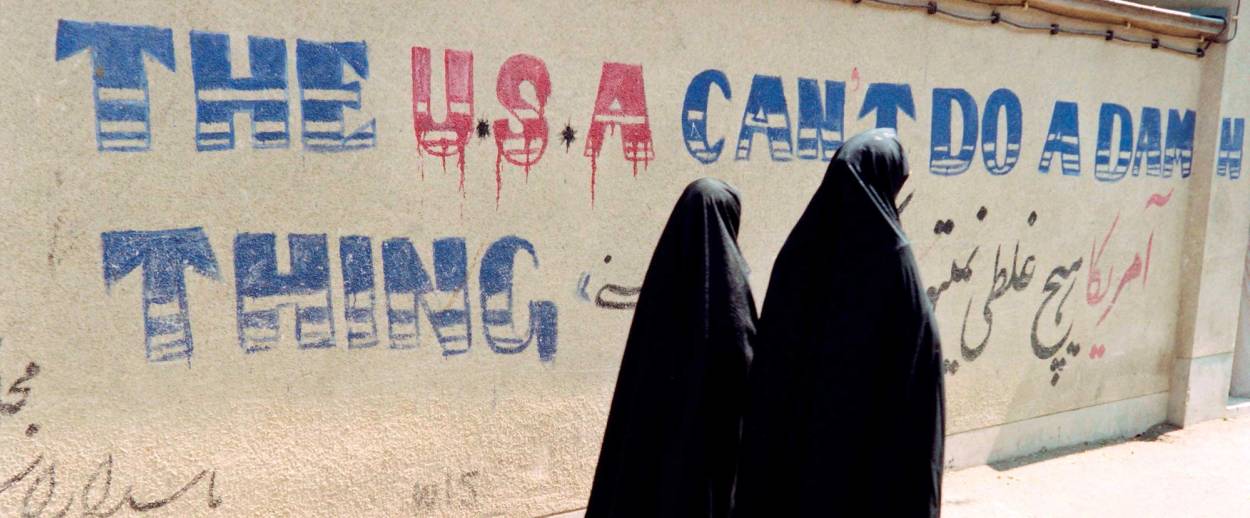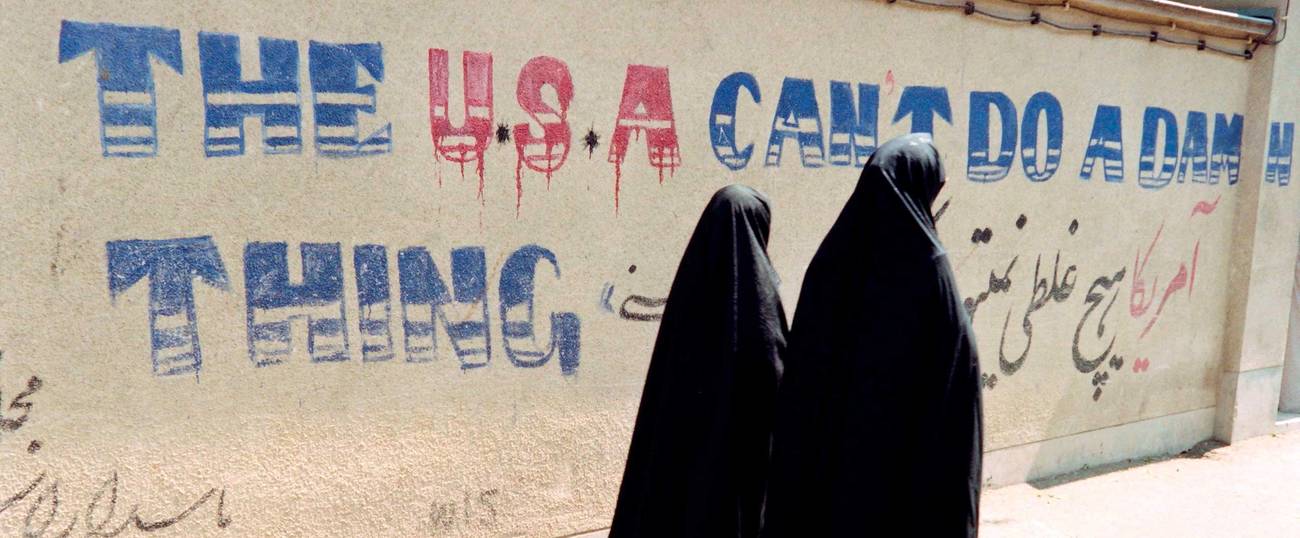Understanding ‘Nofuzophobia’
The roots and legacy of Iranian resentment of the West, part of a weeklong look at 40 years of the revolution




This week, Tablet looks back on 40 years of the Iranian Revolution.
***
On Nov. 4, 2018, a day before the United States reimposed sanctions on Iran, reactions on Iranian social media were divided between criticism of the Islamic regime and various versions of the sentiment “Down with the USA.” In the real world, rallies were organized in “struggle against World Arrogance”—i.e., against the West, specifically the United States.

This hostility to “World Arrogance” was not suddenly induced by the reimposition of sanctions. In fact, in November 2017, Reuters reported that since the Joint Comprehensive Plan of Action (JCPOA) Iran deal was signed in July 2015, the Islamic Revolutionary Guards Corps (IRGC) had arrested at least 30 dual nationals. This is more than double the rate of dual-national arrests before the signing of the JCPOA. Most dual nationals were arrested when they visited Iran on a business or family trip and faced prolonged solitary confinement and interrogations, were denied basic visitation rights, and were usually sentenced—without due process—to long imprisonment or even death, on charges related to national security and espionage.
The Islamic Republic negotiated and signed the JCPOA because the economic sanctions were suffocating the people, and the regime needed to give them some hope. However, regime hard-liners worried that a signed agreement with the West would signal a new cultural openness, leading to an increased expectation for human rights and consumption of Western culture, and thereby strengthening moderate voices and weakening the regime. This was true to some extent; Western investment is vital to Iran’s economy. People, especially the younger generation, embrace Western cultural influence, from Western-style malls and fast food restaurants, to underground rock concerts and parties with dancing and alcohol. Social media activity has proliferated, including fashion Instagram accounts and pages that defy the Islamic dress code.
While Iranians embrace Western culture, they do remain apprehensive about foreign political involvement and interference. One of the fears expressed by many Iranians, people who detest the current regime but do not take active measures to overthrow it, is that because there is no clear alternative, they are afraid the West would interfere again and impose a regime they don’t want, such as the Mojahedin-e Khalq (MEK)—the People’s Mojahedin Organization of Iran, an Iranian opposition group favored by the West. The MEK is currently the most active and most organized opposition movement. It has a ready-to-launch shadow government and president, and has targeted government officials, civil servants, and scientists working for the government. However, because of its Islamist-socialist agenda, as well as its support of Saddam Hussein in the Iran-Iraq war, most Iranians consider it worse than the current mullahs.
The more the people allow the West to penetrate, the more it worries the regime. In political speeches, Friday sermons, and press interviews, clerics and prominent political figures have been emphasizing the need to enhance Iran’s Islamic identity and the struggle against the West. They fear that any compromise may be interpreted as openness to the West. One of the first acts of the regime after the JCPOA was finalized was to pass a series of measures that violated human rights. Instagram models and dancers were arrested, interrogated, and forced to close their accounts and confess on public television. Young men and women dancing together in a clip that went viral were lashed and jailed.
In Persian, foreign penetration, interference, and political, economic or cultural influence, are referred to by the term nofuz. The harsh crackdown in the past few years on dual nationals and dancing-and-fashion Instagram accounts demonstrate increased nofuzophobia—fear of foreign influence—by the regime and individuals identified with the regime.
***
Nofuzophobia is not unique to the Islamic Republic. While resentment of the West was a factor during the 1979 Islamic Revolution (revolutionary ideologues railed against the Westoxification of the monarchy), its roots go back to the beginning of modern Iranian history and identity.
Iran is rich in natural resources such as oil and gas, with fertile agriculture, and most importantly, it lies in an important passageway between Europe and Asia. As the Qajar dynasty began to decline in the 19th century, Qajar kings granted Great Britain and Russia far-reaching concessions in economy, trade, and construction in an effort to replenish their dwindling treasury. Toward the end of the 19th century, the Iranian road system, oil industry, large parts of trade, communication systems, and even homeland security were in foreign hands.
In 1890, Nasserredin Shah Qajar granted British Major Talbot a monopoly on the whole Iranian tobacco industry. The Tobacco Régie affected practically every adult Iranian. The tobacco growers now had to sell their produce to foreigners for a predetermined price, which affected all the 200,000 people employed in the tobacco industry. Consumers now had to buy their tobacco at a price predetermined by foreigners. The landowning clergy, who owned the tobacco fields, viewed this as a blunt invasion and a threat to Islamic values. Modern intellectuals, influenced by the Enlightenment, regarded it as a threat to Iranian independence. The crisis united all layers of society, most importantly the clergy; the bazaari—the traditional middle class; and the intellectuals—who formed modern society.
The Grand Ayatollah Mirza Shirazi issued a fatwa (a religious decree) in December 1891, declaring that tobacco that passed through foreign hands is ḥarām—forbidden. The entire Iranian nation stopped smoking—legend says in less than a week. The concession was canceled in 1892, and Iran got into serious debt to the British, equivalent to roughly US$78.7 million in 2019 values. The Tobacco Revolt, and new social alignments it forged, marked the beginning of almost a century of political activity and set the pattern for other successful ones led by the clergy and supported by bazaaris and intellectuals.
The national anthem of the Pahlavi era alludes to the Qajar-period nofuz: “You were troubled by enemies / in his shade, Iran is quiet.” Shah Reza Pahlavi, in whose days these words were written, revoked all concessions and capitulations granted by the Qajars, but soon enough he made new ones, granting political and economic benefits to foreign governments and judicial freedoms to their nationals on Iranian soil, such as judicial immunity, freedom for religious missionaries, and preserving foreigners’ properties in Iran.
Reza Shah did not survive too long on the throne. During WWII, Russia and Great Britain needed a corridor to transport goods from the Persian Gulf to Russia. In 1941, they invaded Iran and deposed Reza Shah, who was too German-friendly. Reza Shah was replaced by his son, Mohammad Reza Pahlavi.
A decade later, in 1951, Mohammad Mosaddegh was elected prime minister and sought to nationalize Iranian petrol. His effort was supported by all sectors of society, including the clergy, the bazaari, and the intellectuals. In 1953, Mosaddegh was overthrown in a coup d’état, and the shah was reinstated as absolute ruler. Iranian conspiracy theories rumored foreign involvement and were denied by the West. However, these theories were borne out when CIA documents were declassified 60 years later and revealed American involvement in the coup. The day of nationalizing Iranian oil is an official holiday to this day, and Mosaddegh is considered a national hero by different and even opposing political currents, including Islamists and nationalists, but not royalists.
Reza Shah Pahlavi, too, sought to introduce reforms. In 1963, he instituted a series of measures intended to accelerate Iran’s modernization. The other implicit purpose was to strengthen and centralize the shah’s power. These reforms were known as the White Revolution, or the Shah and People’s Revolution. They were not broadly supported, and even angered powerful groups such as the clergy and landowners, who were deprived of their power or wealth by these reforms. The reforms did not work as intended. Land reforms, instead of strengthening the peasants and creating a new social class loyal to the shah, led to expedited urbanization without proper infrastructure, creating a new, frustrated, lower class. The clergy, in particular, were enraged both by their reduced power and authority, and by the increased penetration of Western culture.
One of the strongest voices against these reforms came from a Shiite cleric named Ayatollah Ruhollah Khomeini.
***
The National Day of Struggle against World Arrogance, celebrated in 2018 with protests before the imposition of the sanctions, was not set for Nov. 4, 2018 (Aban 3, 1397, on the Iranian calendar) for that purpose. It was set years before the sanctions were ever issued, and it commemorates three key events in the timeline of the Islamic Revolution:
On Aban 13, 1343 (1964), Khomeini was exiled to Turkey, following his landmark October speech against the shah’s new capitulations. In his speech, he described the capitulations: “If the Shah of Iran runs over an American dog, he will be taken to investigation. But if an American cook runs over the Shah of Iran, he will not be held accountable.” He also said that the Americans are worse than the British, who are in turn worse than the Russians, and stressed that everything that’s bad in Iran is from America and Israel, and Israel is also from America.
The second event, in 1978, was an internal affair in which 56 student protesters were killed by the police.
The third event was the onset of the Iranian Hostage Crisis. On Aban 13, 1358 (Nov. 4, 1979), a group of Iranian students seized the American Embassy in Tehran. Khomeini deemed this event more important than overthrowing the shah, because while the shah was only a symbol of World Arrogance, seizing the embassy was a victory over World Arrogance itself. (Ironically, the young hard-liners who occupied the U.S. Embassy in 1979 are today’s reformists, and many of their children live in the United States: Masoomeh Ebtekar’s son Isa Hashemi is one of many.)
Today, nofuzophobia exists among regime officials and clergy speaking on behalf of the regime, but its use for election propaganda and in Friday sermons in mosques has already lost its efficacy. Even the Aban 13 rallies, as shown in numerous videos on the web, were so small, they would have been invisible if not for the signs carried by demonstrators.
The younger generation has a short memory. Religious coercion has already driven most youngsters away from Islam: Two common trends are din-gorizi—running away from religion, that is, assuming a religion-less (bi-din), rather than a secular, identity; and eslām-gorizi—running away from Islam. People wish to keep their faith without identifying with the coercive regime. Some convert to other religions, usually Christianity, but also Buddhism, and some identify themselves as Zoroastrian. Moreover, many of them view Islam itself as nofuz; Islam is an Arab import from the seventh century CE onward, not originally Iranian, and hence it is nofuz.
Today’s Iranians are again deprived of their natural resources and tax money. This time it is because of the Islamic Republic’s aspiration for regional influence and dominance. Iran’s wealth is invested in wars that serve the Islamic Republic, but not Iran. The revolutionary slogan “Not Eastern, not Western, an Islamic Republic” referred to the interference of the Great Powers in Iranian politics and economy. The popular protest slogan—“Not Gaza, not Lebanon! My soul is devoted to Iran!” (and sometimes also “Not Yemen, not Golan”) rails against the Islamic Republic’s nofuz of other countries in the region.
***
Read more about 40 years of the Iranian Revolution in Tablet’s special series.
Thamar E. Gindin is faculty at Shalem College of Liberal Arts in Jerusalem, research fellow in Ezri Center for Iran and Persian Gulf Research in Haifa University, host of two Hebrew podcasts about Iran—Enriched Iranium and Shortly, Iran—and the author of several Hebrew books about pre-Islamic Iran, including The Book of Esther Unmasked, published in English.